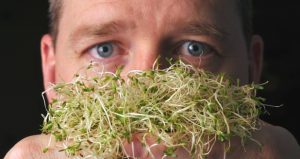Vegetable seeds contaminated with bacterial pathogens have been linked to fresh-produce-associated outbreaks of gastrointestinal infections. This study was undertaken to observe the physiological behavior of Salmonella enterica and enterohemorrhagic Escherichia coli (EHEC) cells artificially internalized into vegetable seeds during the germination process.
 Surface-decontaminated seeds of alfalfa, fenugreek, lettuce, and tomato were vacuum-infiltrated with four individual strains of Salmonella or EHEC. Contaminated seeds were germinated at 25°C for 9 days, and different sprout/seedling tissues were microbiologically analyzed every other day. The internalization of Salmonella and EHEC cells into vegetable seeds was confirmed by the absence of pathogens in seed-rinsing water and the presence of pathogens in seed homogenates after post-internalization seed surface decontamination.
Surface-decontaminated seeds of alfalfa, fenugreek, lettuce, and tomato were vacuum-infiltrated with four individual strains of Salmonella or EHEC. Contaminated seeds were germinated at 25°C for 9 days, and different sprout/seedling tissues were microbiologically analyzed every other day. The internalization of Salmonella and EHEC cells into vegetable seeds was confirmed by the absence of pathogens in seed-rinsing water and the presence of pathogens in seed homogenates after post-internalization seed surface decontamination.
Results show that 317 (62%) and 343 (67%) of the 512 collected sprout/seedling tissue samples were positive for Salmonella and EHEC, respectively. The average Salmonella populations were significantly larger (P < 0.05) than the EHEC populations. Significantly larger Salmonella populations were recovered from the cotyledon and seed coat tissues, followed by the root tissues, but the mean EHEC populations from all sampled tissue sections were statistically similar, except in pre-germinated seeds. Three Salmonella and two EHEC strains had significantly larger cell populations on sprout/seedling tissues than other strains used in the study.
Salmonella and EHEC populations from fenugreek and alfalfa tissues were significantly larger than those from tomato and lettuce tissues. The study showed the fate of internalized human pathogens on germinating vegetable seeds and sprout/seedling tissues and emphasized the importance of using pathogen-free seeds for sprout production.
Fate of Salmonella enterica and Enterohemorrhagic Escherichia coli cells artificially internalized into vegetable seeds during germination
Appl. Environ. Microbiol. January 2018 84:e01888-17; Accepted manuscript posted online 27 October 2017, doi:10.1128/AEM.01888-17
Da Liu, Yue Cui, Ronald Walcott and Jinru Chen
http://aem.asm.org/content/84/1/e01888-17.abstract?etoc
